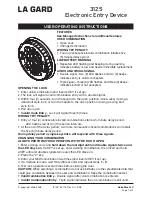
The loop may also be read out on a ‘one-shot’ basis. This is accomplished by pushing
the # key. After the # key has been pressed the edited loop will be read out once and will
not be read out again until the # key is pressed again. The loop may now be read out
continuously by pressing the ‘D’ key.
The loop may also be audio triggered. In this case the ‘locked in’ audio will be read out if
an audio signal of sufficient level to illuminate the green LED is applied to channel ‘a’.
Cautionary Notes
Having come out of the lock-in mode, there is no point re-entering until the maximum
‘tape loop’ time has elapsed. If re-entry prior to this is attempted the resulting audio
signal will contain a mixture of the previously locked loop and new audio data.
DO NOT
switch the power on with the lock-in function selected as random data in the
RAMs will be locked in and sent to the audio chain at a high level.
Reverse Loop
Reverse loop is achieved by typing the end stop value at the beginning of the loop and
the start point value at the end of the loop.
Example:
For a unit containing 6.4 seconds of lock after the initial throwing of the lock switch, the
unit displays the word LOT. Entering A # will cause the unit to display 6.400 (or
maximum value of lock for that particular channel). At this point 0 should be entered.
Pressing the A key again will result in the display still reading zero but LED mark ^ will be
illuminated, 6.400, or whatever value required, should now be entered. The unit is now
in reverse loop mode and can be triggered as before, that is, with the audio trigger or the
hash key. It should be noted, however, that there is no provision for pitch change while
the loop is in reverse mode.
-
If the start time entered is greater than the end time there will be no output.
In Phase / Out Switch
When the ‘in phase/out’ switch is depressed the output of channel ‘a’ is out of phase with
the input, a useful device for creating various ‘tunneling’ effects if used in conjunction
with the re- generative controls, the nudge controls and the output mix switch.
Nudge Controls
Altering delays
The nudge buttons may be used to edge the selected delay up or down, an indication of
the direction is given by the LEDs to the right of the display. These buttons when used
change the displayed delay, and also the value in the respective store location, by
approximately 2mS/Second in 25µS steps producing a smooth, virtually silent change in
the delay time.
Pitch shifting
The nudge buttons may also be used for pitch shifting and are most effective for pitch
searching and tuning.
S-DMX User Manual
Page 8
Issue 3
Summary of Contents for S - DMX
Page 3: ...S DMX S DMX User Manual Issue 3 Page 1 ...
Page 4: ...S DMX User Manual Page 2 Issue 3 ...
Page 24: ...S DMX User Manual Page 22 Issue 3 ...
Page 30: ...S DMX User Manual Page 28 Issue 3 ...
Page 32: ...S DMX User Manual Page 30 Issue 3 ...
Page 33: ......











































